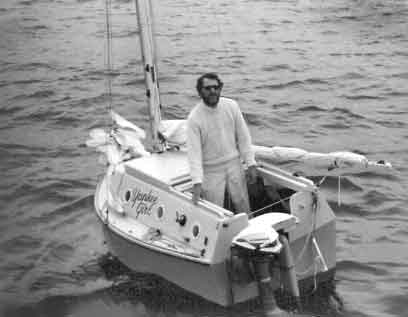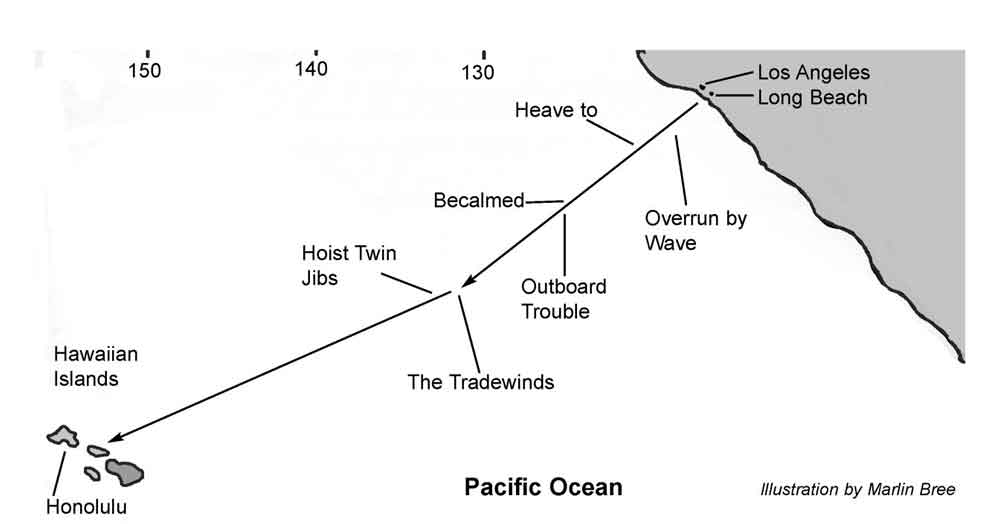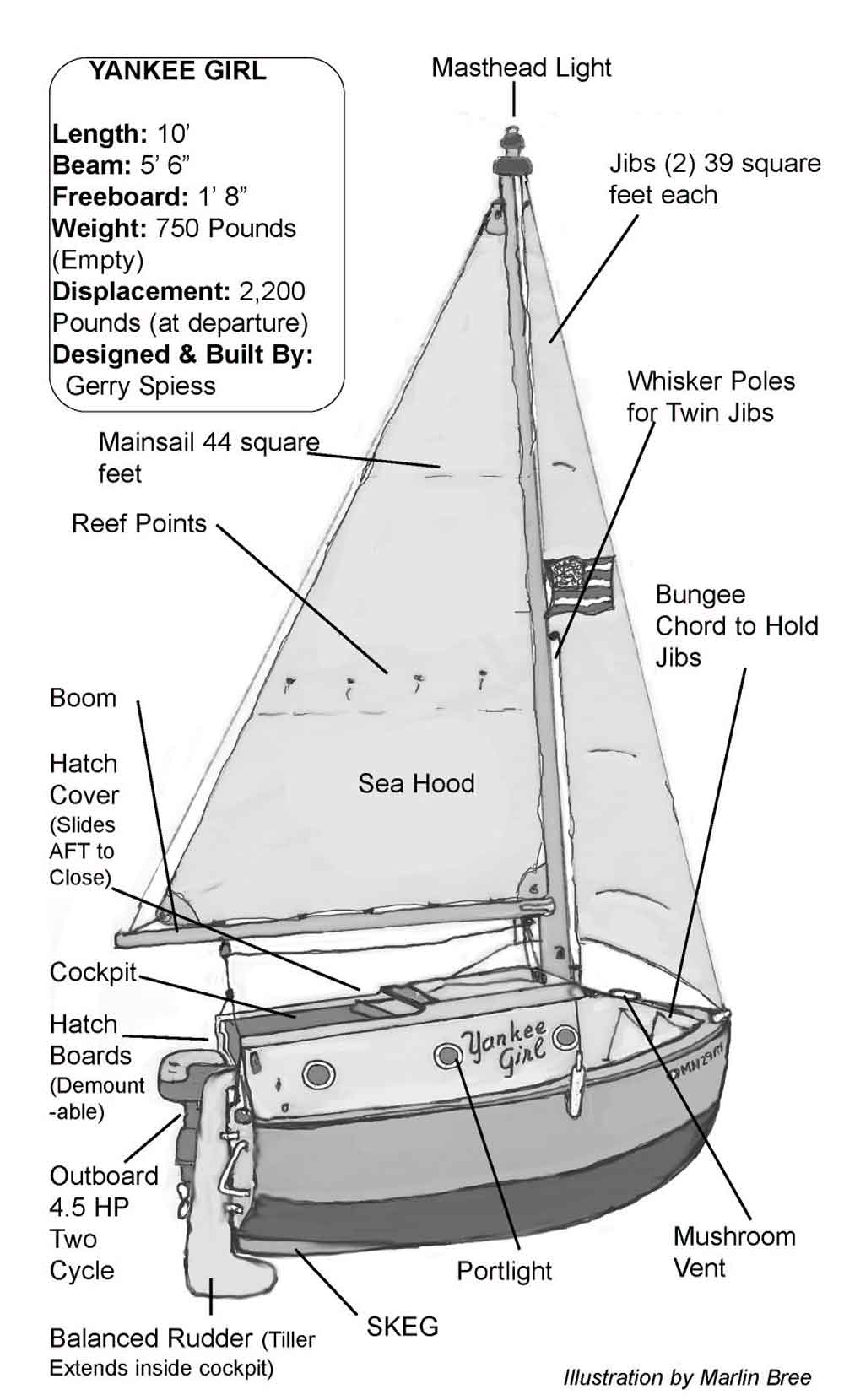
Copyright 2005
From Broken Seas
TEN FEET ACROSS THE PACIFIC
Gerry Spiess heads Yankee Girl toward Hawaii
PROLOGUE
In 1979, Gerry Spiess sailed Yankee Girl solo across the North Atlantic Ocean to
set a world's record for the smallest boat crossing, west to east. It took him
54 days to sail 3,800 miles from Virginia Beach, Virginia to Falmouth, England.
It was a remarkable voyage, by any standards, for a plywood boat he had built in
his garage in White Bear Lake, MN.
Two years later, he wanted to sail his tiny craft nearly 7,800 miles across the
world's largest ocean. He had shoved off from Long Beach, California, hoping to
quickly pick up the South Pacific's steady and balmy trade winds. His first port
of call, Honolulu, Hawaii, beckoned to the west. But the Pacific had turned cold
and treacherous.
 |
| By Marlin Bree Copyright 2005 From Broken Seas |
Episode 1 of 2 episodes
A full moon had arisen over the South Pacific Ocean, and, in its silvery light,
ominous big rollers were forming and breaking. Long waves were peaking up, with
white breakers beginning to overhang the small boat. They slammed hard into her
transom, giving her nasty shoves.
Alarmed by his boat's motion, Gerry Spiess threw open Yankee Girl's hatch. A
chill wind brushed his face as he looked out at the waves: they were starting to
run confused and piling up. A splash of spray hit him in the face - the water
was remarkably cold.
It wasn't supposed to be like this.
Voyaging in the South Pacific was supposed to have sunshiny days in warm trade
winds with tropical nights ablaze with stars. But this trip was turning nasty.
It was the evening of the ninth day, and, the waves were rearing up to
overshadow the ten-foot sloop. He had entered the convergence zone, where a cold
current runs down from Alaska and meets the warm central current. Big rollers
were starting to form and break.
 |
| Yankee Girl with skipper Gerry Spiess. Photo / Lou Spiess |
When the wind changed direction, it had created two sets of waves. One set of
waves was running 8 to 12 feet; the other waves ran at more than 8 feet. Worse
yet, the wave trains were starting to collide as the wind came around.
Slamming his hatch shut, Gerry slumped back into his cabin and the warmth of a
sleeping bag. He was thankful that he had decided earlier to take down all sails
and run under bare poles - a standard procedure for rough weather.
But he knew he was in for a rough night.
Hawaii was more than 1,800 miles away - and looking increasingly distant.
 |
There was a heavy thump, and, suddenly, sheets of water poured through the
closed hatch. Startled, Gerry looked up to see a small Niagara flooding inside
the cabin.
A following wave had overrun Yankee Girl, buried her in the water. She had
turned into a submarine, with only her mast sticking out. The water pressure had
blasted through the sliding hatch closure.
Moments later, she fought her way free of the wave, but Gerry knew his boat was
in danger. Yankee Girl was heavy laden. The steep seas, closely bunched, were so
bad that even running under bare poles wasn't working. She couldn't take any
more waves over her transom.
He had to take action and that meant going out on deck. Timing himself between
waves, Gerry threw back the hatch and crouched on the wet deck as Yankee Girl
pitched below him.
In the moonlight, he could see a big wave roaring toward him. He managed to
close the hatch below him. There was not a lot to hang on to, but he lunged
forward on the cabin top to the mast, in the peculiar scuttling motion he had to
use on a tippy boat with a five-and-a-half foot beam.
 |
With one hand on the mast, he inserted a foot on the starboard shroud and chain
plate and crouched down. The wave roared over the transom and overran the boat,
splashing him as he worked. With its weight, Gerry felt the boat careening
momentarily over to one side. Yankee Girl hesitated, then righted herself. From
his position, he could reach forward with one hand to pull out the jib, which
was lashed under shock chord along the bow's starboard side.
Coolly, he hanked it onto the forestay. He tied the jib halyard to the sail and
crossed the jib sheet to the opposite side.
Minutes later, he had the mainsail unlashed along the boom.
Wet and chilled, he tumbled back into the cockpit and hoisted the deeply reefed
main and the jib. After he threw the tiller to the opposite side, Yankee Girl
obediently turned, pointed her bow into the wind, and heaved to.
The effect was astonishing and immediate. It seemed as if the ocean had gone
suddenly calm; Yankee Girl slowly would move forward, then fall off, stall out,
move a little backward, then resume her motion forward.
Instead of being bashed in her broad, flat transom by the heavy waves, her
pointed bow speared into them and shoved them to one side. With her sails up,
she had balance and direction.
Gerry sighed with satisfaction. Heaving to was one of the heavy weather
maneuvers Yankee Girl excelled at. She did not do well lying to a sea anchor,
for, she would sail forward and overreach, making it useless in waves.
But with her v-shaped hull, and long keel, she could heave to very steadily,
even in broken seas, and work easily with the waves, like a little fishing
bobber.
A last look, and, Gerry slammed the hatch shut and dogged it down. He had done
all he could for his little boat. Now she'd have to look after him.
By dawn, he sensed something was different. The motion of Yankee Girl had
changed. His muscles aching from the long night of lying heaved-to the waves,
and his skin itching from his damp bunk, Gerry threw open the hatch. He blinked
in the early morning light.
The sun was high in the sky, but the Pacific spread lumpy seas to every horizon.
Gone were the breaking seas of last night, but Yankee Girl's sails were
beginning to slat and flutter.
Gerry realized that they had gone from too much wind to not enough.
They were becalmed.
He scratched his heavy salt-soaked beard and peered over the transom - his
engine was still there on its motor mount. It had been repeatedly doused as
waves overran the boat. It must have been battered by thousands of breakers:
he'd heard it shudder and bang. More than once during the night wondered if it'd
been torn off.
But it was a two-cycle outboard and he'd always had great luck with the
two-cycles, even on his stormy North Atlantic crossing, where his 4-hp. Evinrude
had been repeatedly doused. Behind him now was a brand new 4.5-hp. engine.
These engines always fire up, Gerry thought as he pulled the starting cord
easily through to get the gas up.
Then he yanked another time - hard.
Nothing happened.
He tried again and again, but the outboard would not start. It would spin
through, but not catch and fire up. He began to perspire and not just from the
exertion.
Had something broken in the storm? Without an engine, he would be in deep
trouble. He needed the small outboard to get back on schedule in the calms, and,
to get into harbors. It was a critical part of his strategy.
More tries at starting the engine would not help - it was time for a new tactic.
He took his hand from the starting chord, his arm already starting to ache.
What was the problem? The first guess came quickly. Electrical, probably. That
was always a good guess on boats. Out of curiosity, he raised the throttle arm
and peered beneath. The engine had a shut-off, or kill, button at the end of the
throttle arm. If you pushed the button, the engine stopped.
He saw what was causing the problem. Somehow, the waves had shorted out the kill
switch. With a needle nose pliers from his repair kit, he snipped its wires -
hopefully bypassing the problem.
He crossed his fingers, and, hauled hard on the starter cord. With a whuff of
smoke, the little two-stroke started up and soon settled into a raspy idle.
He set his course toward Hawaii, running with his engine just barely turning
over at a fast idle - at a stately cruising speed of around 2.2 knots (2.53
mph.) - which he maintained almost nonstop day and night for the next 6 days. To
refuel, he'd unscrew the filler top of his six-gallon main gas tank, pour in gas
from one of many gas cans he carried in the bilge, screw back the top, and,
continued cruising - without stopping his engine. He did shut his engine off
several times to change the engine's single spark plug - cheap insurance, he
figured.
The slow but consistent running was part of his crossing strategy. It took
patience, but gave him great gas mileage. At the speed he ran the engine, the
two-cycle single cylinder engine only used a fraction of a gallon per hour. That
meant one gallon of pre-mixed gas and oil would last more than seven hours. A
24-hour day's run would consume only 3.5 gallons. He carried 54 gallons of
pre-mixed gas on board, most of it in the bilges, down low for ballast.
At low speeds, Yankee Girl's power cruising was effortless, but noisy. When he
was routinely piloting the boat, he sat in the aft bunk, with his head near the
transom and the outboard, or, when he slept in short periods, he had his head
just a few feet from the engine. He found he couldn't get away from the
outboard's noise - particularly annoying for a wind sailor.
He began to be aware of another problem. Inside the cabin, Gerry sniffed the air
to discover the faint, but unmistakable smell of two-cycle smoke.
He sat up straighter. If that were coming back into the open hatchway, there
might be something else: the deadly invisible, odorless killer - carbon monoxide
gas.
With a light, following breeze, but not enough wind to power up the sails, there
was no escaping the problem that heavier-than-air carbon monoxide was finding
its way into his tiny cabin, and, down into the bilges.
He tried keeping the hatch open only one or two inches, which was only a partial
solution, he realized. He also found he couldn't sleep well or for very long.
The engine droned on.
He began to yearn for the trade winds.
* * *
In the next episode, Gerry and Yankee Girl enter the trade winds and scoot
toward Hawaii. This material is excerpted from Marlin Bree's book, Broken Seas:
True Tales of Extraordinary Seafaring Adventures (copyright 2005 Marlin Bree).
Visit his website at www.marlinbree.com.